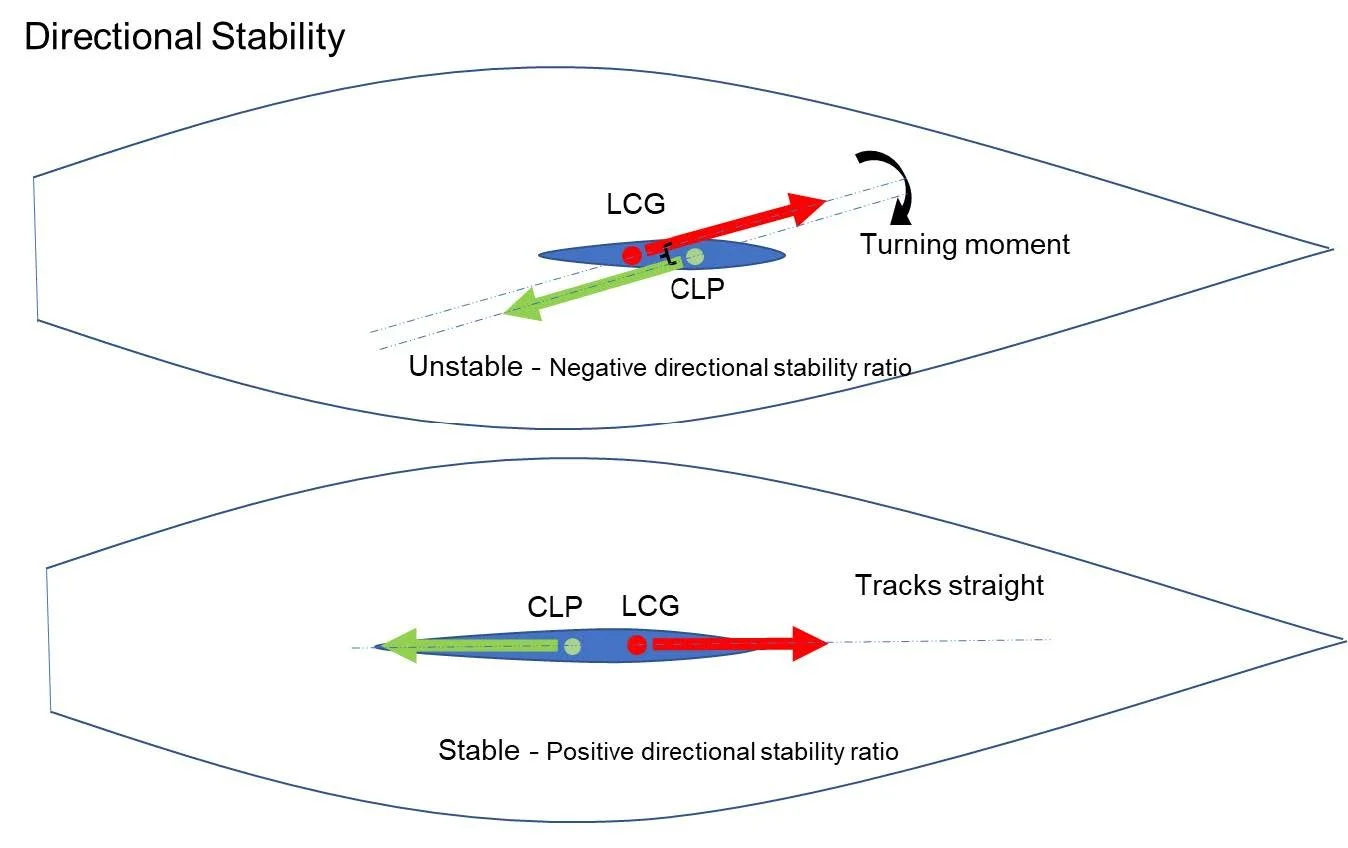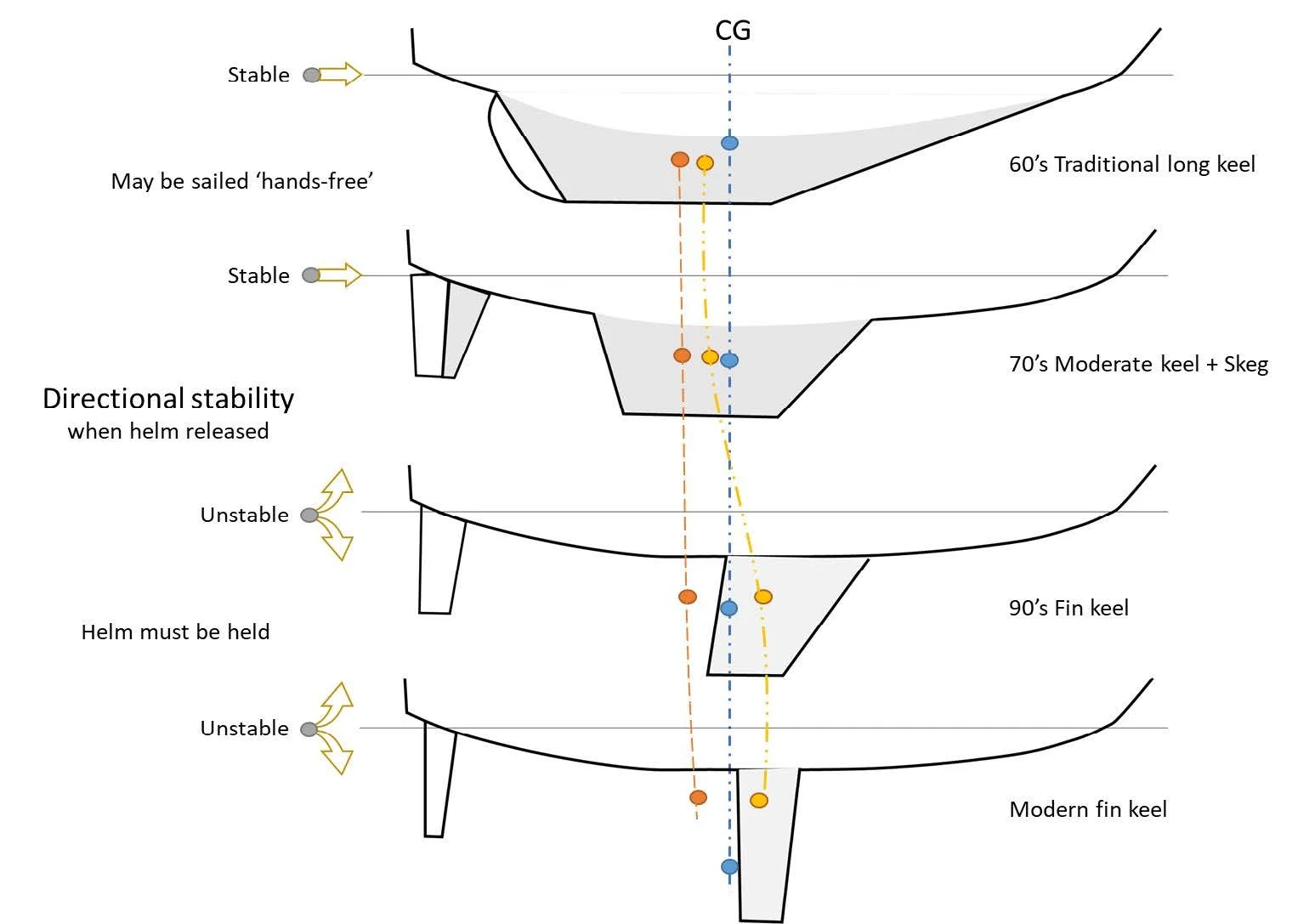Classic Performance - Part III
In this third piece by Ian Ward we look at what makes
A DIRECTIONALLY STABLE YACHT
There are several significant differences between traditional classic yachts and modern fin keel designs which affect their handling and performance. These involve directional stability and hull balance, the effects of which are addressed in this article.
Directional Stability
The upright directional stability of a yacht plays a significant role in determining its steering and handling characteristics. Directional stability is conferred when the Centre of Lateral Plane ‘CLP’ is aft of the Longitudinal Centre of Gravity ‘LCG’. If CLP moves forward of LCG, it destabilises the craft by applying a turning moment which is exerted by the lateral plane pivoting around the centre of gravity. Conversely, when CLP is aft of LCG, there is no turning moment acting so the boat tracks straight. This is the same principle by which planes, arrows and rockets fly straight.
Illustration of the forces acting to cause directional stability/instability
The position of the centre of gravity and centre of lateral plane of any boat may be determined from a design drawing or experimentally from the actual boat sitting in the water. In essence, push the boat sideways in the water to find its neutral or balance point at CLP and walk from one end towards the centre, to locate it’s LCG at its balance point.
In a yacht, when the tiller is held steady amidships by the skipper, the rudder naturally becomes part of the lateral plane. Let the helm go and the rudder is free to turn, so the lateral plane then does not include the rudder. As a result, the position of CLP changes significantly, moving forwards in the boat. Holding the rudder can therefore induce a temporary state of ‘unstable equilibrium’, enabling the boat to track straight.
For ‘older’ classic yachts with their longer keels or skegs, CLP is located well aft of LCG, so even if the rudder is left to turn freely, these boats still tend to track straight. In essence, the boat ‘lets you know’ where it wants to go and your role is to “guide” it. This is why the tiller can be released and the boat continues to track straight, making these boats docile, easy to handle with little stress for the skipper, explaining why they are favoured for cruising yachts. Planes, cars and bikes are all designed to be directionally stable.
On the other hand, modern ‘fin-keeled’ yachts and sailing dinghies with their keel or centreboard well forward in the boat, only track straight while the rudder is held. When released, CLP moves ahead of LCG and the boat immediately becomes directionally unstable. As a result, they turn rapidly and easily, making them highly manoeuvrable and agile, but they do require constant attention to the helm to maintain a steady course. In essence, the skipper tends to constantly “direct” the boat which usually responds easily. This explains why these boats are considered ideal for close racing around the buoys, but are not necessarily preferred for single handed sailing or cruising.
Stable Equilibrium
A boat is directionally stable when CLP is aft of LCG, even when the rudder is free to turn. It is said to be in a state of ‘stable equilibrium’. These craft such as traditional yachts and displacement motor launches, paddle boards & surf boards with long keels or skegs aft tend to track straight ‘hands free’ without the need to hold the tiller and they also track straight under tow, but are directionally unstable and difficult to steer when moving backwards as CLP is then ahead of LCG.
Directionally stable yacht with CLP excluding the rudder, aft of CG
Unstable Equilibrium
A boat is directionally unstable when CLP is ahead of LCG ie: when the rudder is free to turn, however it attains a state of ‘unstable equilibrium’ when the rudder is held, as CLP then moves aft of LCG. These craft, such as sailing dinghies and modern fin keeled yachts with spade rudders, are only directionally stable while the rudder is held amidships. When the rudder is released, they become directionally unstable. Conversely, they can be steered quite effectively when going backwards, as they become stable in that direction.
Directionally unstable yacht with CLP excluding rudder, forward of CG
Turning
When turning a directionally stable yacht, the rudder must overcome the resistance to turning of the keel or skeg. The helm is held over until a new course is set. Once the helm is released however, the boat will stop turning and the rudder, located behind the keel or skeg, tends to self-centre, so the boat naturally establishes a new course. A spade rudder does not tend to self-centre. This type of boat can be slow to turn and the helm is often heavy, but it feels somewhat satisfyingly easy and safe to sail as it tracks straight and maintains a stable course, by itself.
A directionally unstable boat behaves quite differently. Only a light load is required to set the rudder at a small angle to the water flow to initiate ‘instability’ in the desired direction. Thereafter the boat will turn itself. There is no need to maintain pressure on the rudder. You can even release the helm and it will continue to turn. Once the new heading is reached however, the rudder needs to be brought back to the centreline by applying a significant force to arrest the turn and assume the new heading, with the rudder held to keep it tracking straight.
This unstable arrangement produces a very manoeuvrable boat when tacking, turning around a mark or in tight situations and in close company. In fact, the feeling is quite seductive, as you sense the boat ‘wants’ to turn and that you do not have to ‘force’ it. This is one key reason why skippers of racing yachts prefer directionally unstable boats. It does however, require constant attention to hold a course, which can become wearing over time and unsafe if the tiller is released.
The cause of this ‘responsive’ steering is not necessarily due to just the shorter ‘chord’ or length of the keel, nor to the size of the rudder, but most importantly the sense and magnitude of any directional instability. The centre of lateral resistance also plays a role in turning any craft, but does not alter the fundamental relationship between CLP and LCG.
Another aspect of steering is that keel or skeg hung rudders tend to self-centre when released while turning, while a spade rudder continues to turn the boat when released, even if the yacht is directionally stable. This is due to the influence of water flowing around the keel or skeg.
A history of transition
During the latter part of the 20th century, a key focus in yacht design was to reduce the surface area of the keel and increase its aspect ratio to improve performance. Traditional longer keels were progressively replaced, firstly with shorter keels and skegs, then fin keels and finally the modern deep fin with bulb and spade rudder.
Changes in directional stability with keel types
The most notable change is that as the keel size was reduced, its location was naturally moved well forward in the boat to provide the necessary structural support for the ballast near the centre of gravity. As a result, the centre of lateral plane (rudder excluded) also moved well forward in the boat. So far in fact, that CLP moved ahead of the centre of gravity and these boats have become directionally unstable when the helm is released. The consequence of this is a complete change in handling characteristics. As a result, these latest designs tend to have ‘dinghy-like’ handling qualities.
In PART IV of this series, the effect of hull balance and rig balance is discussed.






